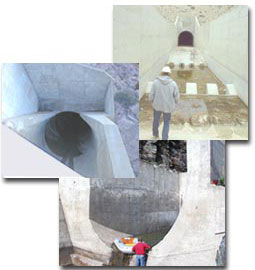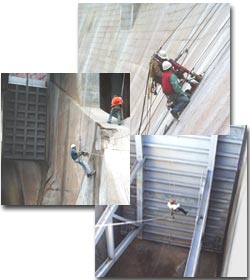- Reclamation
- Upper Colorado Basin
- Provo Area Office
- Safety of Dams
Safety of Dams

The performance of dams is monitored in accordance with the Safety of Dams Act which encompasses two separate programs, the Safety Evaluation of Existing Dams Program, and the Safety of Dams Program. These programs were implemented in 1978 after the passage of the Reclamation Safety of Dams Act, which was amended in 1984. These programd are intended to ensure that Reclamation facilities do not present unacceptable risks to public safety, property, or welfare.This is accomplished by identifying structures that without modification, would pose unacceptable risks. Implementation of corrective modifications are intended to reduce or eliminate those risks in an efficient and cost-effective manner.
[Read about dam safety modifications to Utah facilities]
An unacceptable risk is defined as the possibility that one person may be harmed by a deficiency. Reclamation policy is to provide safe structures, but this does not imply a risk-free environment. A safe dam is one which performs its intended function without imposing unacceptable risks to the public by its presence.
Dams are evaluated for deficiencies in three ways. First, statically, meaning how likely, and to what extent, the dam will suffer from seepage and piping failure. All dams seep, but the key is to control the seepage through properly designed and constructed filters and drains. When seepage is properly controlled, the risk of piping or embankment failures is greatly diminished.
Second, ams are evaluated hydrologically, meaning how likely and to what extent the dam can withstand a large flood. Adequate sized spillways in conjunction with unused reservoir capacity, are used to accommodate significantly increased inflows due to rare storm events to prevent overtopping of the dam.
Third, dams are evaluated seismically, meaning how likely and to what extent the dam will suffer damage from seismic events. Dams are designed, constructed, and modified, when necessary, such that a catastrophic failure is prevented during a large earthquake.

A major part of the SEED Program is the facility review component. All Reclamation facilities undergo a comprehensive facility review, periodic facility review, and an annual facility examination. The basic objective is to quickly identify dams which may pose an increased threat to the public, and to quickly complete the related analysis in order to expedite corrective action decisions and safeguard the public and associated resources. The Comprehensive Facility Review which evaluates every aspect of the facility for static, hydrologic, or seismic deficiencies, is conducted by Reclamation's Denver Technical Service Center on a six-year cycle. For facilities in the UC Region, periodic facility reviews are conducted by engineers from the Regional Office located in Salt Lake City, Utah, and are on an alternating basis with the comprehensive facility reviews every three years.
The annual facility examinations for facilities in Utah and surrounding areas, are conducted by engineers from the Provo Area Office, located in Provo, Utah. The periodic facility reviews and the annual facility examinations focus mainly on operation and maintenance issues at the facilities. The comprehensive facility reviews are detailed evaluations of all components of the dam and utilize data collected from every aspect of performance of the facility. Dam monitoring instrumentation installed at the facilities provides the performance data needed for the evaluation. This data is usually collected by the dam tender.
Any studies, or investigations such as drilling done at a dam as part of the SEED Program is done to determine if a deficiency exists. The federal government pays for 100 percent of the cost of these type of evaluations. If a deficiency is identified, the dam is moved over to the SOD portion of the program. The first step under the SOD Program is defining the corrective action required and determining the cost of the correction actions. A report is then produced which is sent to the Office of Management and Budget and the U.S. Congress for approval. This report includes environmental impacts of the remediation, an evaluation of economic and social impacts, a list of preferred methods of repair, and their associated costs.
Upon approval, the dam is then modified to reduce the risk presented by the deficiencies to an acceptable level. The federal government funds 85 percent of the SOD expenditures, with water users paying the remaining 15 percent.

